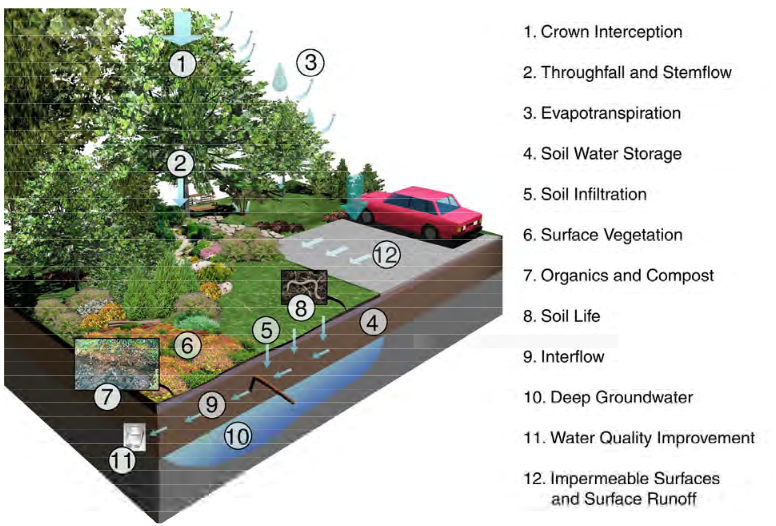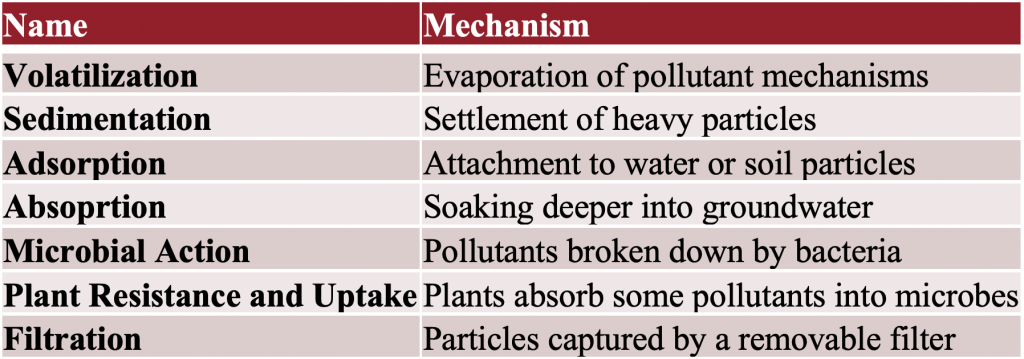Module 4: Design Principles of GI
Learning Objective
- Identify the basic design principles that make GI work and how design can inform site locations for GI
Green Infrastructure systems rely on a number of environmental and operational principles to provide the broad array of services. These principles, along with the science, engineering, and materials needed to harness them for effective green infrastructure, are well-established. However, they continue to be updated and refined in response to research studies, municipal experiences, and technical innovations. In this module you will explore the current state of green infrastructure science: what is known, what is still being studied, and what the implications are for GI design and planning.
Stormwater management is a significant motivation for GI implementation. In most urban and suburban areas, rainfall flows quickly along hard surfaces and enters the storm sewer system within five to 10 minutes. This short lag time between the rate of rainfall and the rate of sewer flow means that periods of intense (i.e. peak) rainfall inevitably lead to periods of intense sewer flow that may exceed the capacity of municipal sewers, leading to flooding and combined sewer overflows. The process of slowing water down so it does not quickly enter storm sewers is referred to as peak flow reduction. GI systems that aim to reduce the peak flow into municipal sewers have two primary components: storage capacity and discharge control. Green Infrastructure storage capacity holds rainfall onsite before it can enter the storm sewer system, increasing the time that it takes for rainfall to turn into sewer flow. This storage can be provided in soil, gravel, and may include above-ground and below-ground components. For GI systems to drain properly and retain capacity for future storm events, a discharge path must be designed to drain the system within a time frame deemed acceptable by city planners and policy-makers (usually between 12 and 48 hrs). This time-period is referred to as the maximum drawdown time.
The Water Budget Table is a tool intended as a visual indicator of the distribution of mass outflow among event runoff (Q), evapotranspiration (ET) and percolated or stored drainage (I). You will read about this in the article by Eger et al.
Water Budget Triangle
Source: Page 2 of https://www.researchgate.net/publication/286426965_Water_Budget_Triangle_A_New_Conceptual_Framework_for_Comparison_of_Green_and_Gray_Infrastructure
Water can leave a GI system through several pathways. GI systems may be designed to infiltrate a portion of rainfall into groundwater reserves in order to replenish depleted groundwater reserves and improve regional water security. When the underlying soil cannot infiltrate fast enough to drain the system, a perforated underdrain may be installed at the bottom of a GI system to slowly drain saturated soil layers. The vegetated components of GI turn some rainfall into water vapour through evapotranspiration. Once the surface and subsurface storage capacity of a GI system is full, an overflow pathway should be designed to ensure that excess water spills into the existing storm sewers and not into homes and businesses. Establishing infiltration rates and evapotranspiration rates is an essential part of GI design. There are a variety of technical procedures and scientific equations used for establishing these variables. Municipalities that adopt a single standard for determining them can decrease the design costs for developers and the review burden for municipalities.
Source Control
Just as rainfall hits all areas of a development site, the design of stormwater source controls should be integrated with the entire development concept. The Metro Vancouver Source Control Guidelines document in your readingsoutlines a design process for stormwater source control practices – identifying key steps and their arrangement in a typical development process. This document is used widely in the Metro Vancouver area.
Stormwater Variables of Absorbent Landscapes
Source: Stormwater Source Control Design Guidelines, page 2-1
GI systems are increasingly being used to prioritize a specific performance outcome. Where heat island reduction is a priority, plants with high evapotranspiration rates may be used to shed heat from the surrounding area. Where infiltration is a priority, systems can be designed to maximize their underground surface area or can use sandy soils with high infiltration rates. If a system is intended to maximize peak flow reduction, additional surface storage (through increased area or depth) can be provided to hold more rainfall onsite. GI systems that aim to improve water quality rely on bioretention or biofiltration to trap pollutants in soil and absorb pollutants into the systems biomass. Plant selection can be used to target specific pollutants of concern. Bioretention relies on a number of mechanisms to remove pollutants: volatilization, sedimentation, adsorption, absorption, microbial action, plant resistance and uptake, and filtration. Bioretention pollutant removal can also be targeted towards specific pollutants of concern by using soil amendments shown to improve desired outcomes. The mechanisms of pollutant removal and the soil amendments used to supplement them, are described further in the supporting images of this module (Mangangka et al, 2015). Cities such as Vancouver, Ottawa, and Portland are also using city GIS data to incorporate other variables into GI design and planning decisions, such as the absence of existing green spaces or the compatibility of existing infrastructure constraints (Jolliet, 2019; Coutts, 2016; Dunn, 2010).
Planting is a significant dimension of GI and there is a great deal of knowledge about what works under what conditions. Plants are a natural form of pollutant removal. Numerous resources are available in the reading section that provide lessons learned, planting guides and other landscape related materials.
Pollutant Removal Mechanisms Used in GI Systems
Source: Stiffler, 2013., Table By Nick Mead-Fox
Another principle that municipalities and private firms often refer to when planning and implementing GI systems is the impervious to pervious (IP) ratio. The IP ratio is a ratio of the amount of impervious drainage area directed towards a given pervious green infrastructure area. This ratio can capture many aspects of GI design. It can account for erosion potential in the cell, volume retention, water quality improvements, and heat island reduction by setting the IP ratio to the most limiting performance variable. Many municipalities use an IP ratio to provide quick estimates of system sizing in a particular drainage area. A standard IP ratio depends on a standard design, as changes in GI design such as increased ponding depth or filter media depth can increase the acceptable impervious drainage area. By committing to a specific IP ratio, municipalities may not be accounting for the impact of design variations and consequently they can stymie GI innovation. However, a maximum IP ratio can also help ensure that green infrastructure systems are not undersized and that GI can serve the multiple purposes for which it should be designed. This is just one example of the difficulties in providing dependable guidelines to ensure GI systems perform well without tying the hands of designers and preventing them from pursuing innovations in a rapidly changing field.
The readings for this module will introduce you to the Water Budget Triangle, source control guidelines, as well and overview of key terms that describe how design principles are applied in GI. The short videos discuss the application of design principles in GI, demonstrate how bioretention operates and, for example, how a rooftop garden functions to capture and store rainwater. Be sure to view the video presentation by City of Vancouver Engineer, Rob Lukes who provides a detailed explanation of considerations and myths of bioretention design.
Learning Activities
- After reviewing the introduction to this module, the reading and videos, create a one page set of definitions for the following concepts:
- Source Control
- Biofiltration
- Peak Flow Reduction
- Infiltration
- IP Ratios
- Pollutant Removal Rates
- Planting Materials in GI
Discussion Questions
- Imagine that your neighbour or colleague is curious about how GI works. What is one design principle from the list you have created that you would share with them and why? What questions remain for you about the the design principles of GI?
Readings and Resources
Readings
Recommended:
- Landscape Urbanism and Green Infrastructure (Assessing Stormwater Nutrient and Heavy Metal Plant Uptake in an Experimental Bioretention Pond – pg. 108-124) (Full book available to read on Google Books)
- Comparative Performance Assessment of Bioretention in Ontario – CVC (6 pages)
- International Stormwater Best Management Practices (BMP) Database Advanced Analysis: Influence of Design Parameters on Achievable Design Parameters: 1-10 https://doi.org/10.1061/(ASCE)EE.1943-7870.0000227
- Water Budget Triangle: A New Conceptual Framework for Comparison of Green and Gray Infrastructure
- Water Wise Planting Plan (West Coast of North American)
Optional Resources (if you have time):
- Credit Valley Conservation (Ontario) LID Landscape Design Guide
- Montgomery Country (suburb of Washington, DC, very progressive in their GI implementation) – Guide to Rain Garden Planting
- New York City – very prescriptive planting plans for GI in road ROWs. Starting at sheet GI-501A
- Designed plant communities – Phyto Studio
- Metro Vancouver Source Control Guidelines Very useful design guidance widely used within the region. Generally very good but oriented more towards suburban built forms. Currently being updated to modernize.
Videos:




